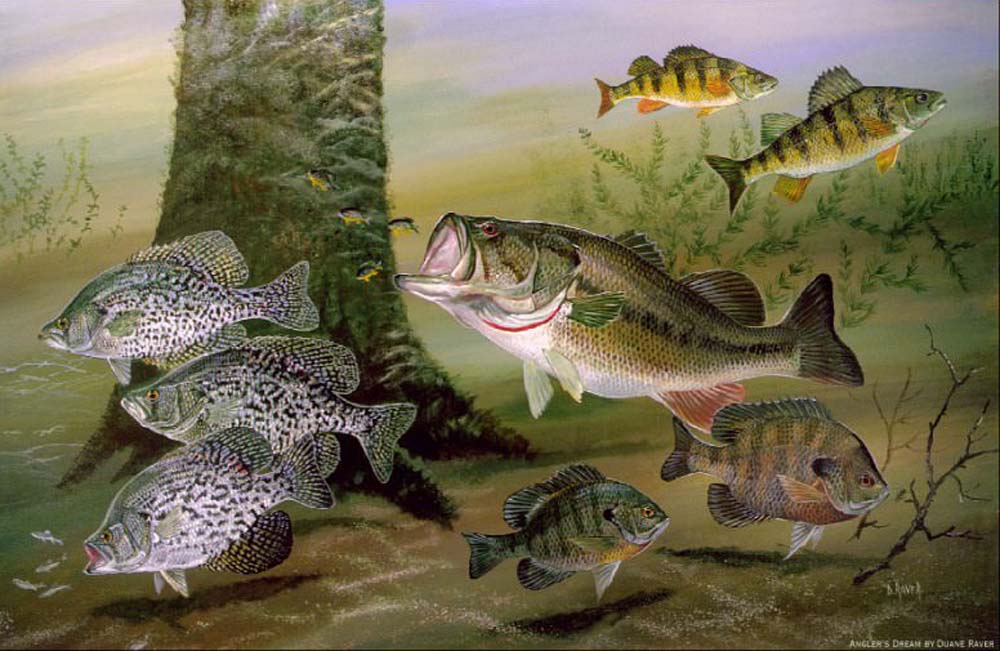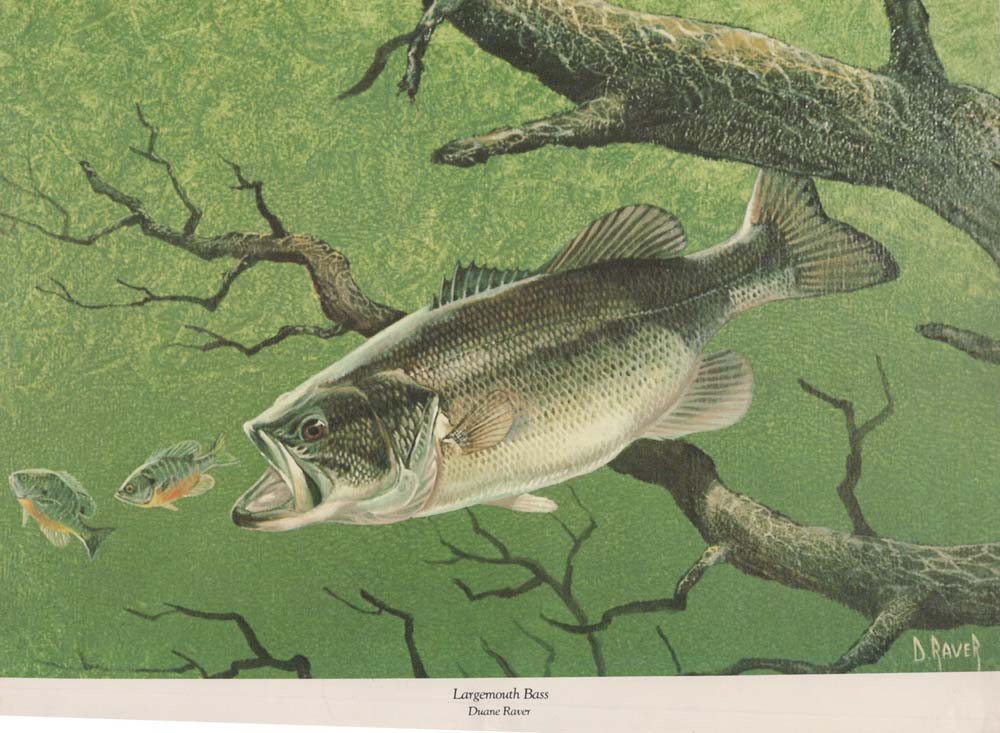
Largemouth Bass Drawing
The Evolutionary History of the Black Bass Genus Micropterus sp.
Scientists used a molecular clock to determine all eight species of black bass (Micropterus) share a common ancestor that lived eleven million years ago. The oldest bass fossil was unearthed in Texas and dated to 23 million B.P. [Before the Present]. Based on molecular clock data, scientists estimate the Micropterus (black bass) genus originated about 26 million years ago.
Fast forward 15 few million years
Today, eight bass species began to diverge from a common ancestor 11 million years ago when a marine transgression flooded most of the coastal plain in the southeast. This dramatic rise in sea level isolated many bass populations, resulting in allopatric speciation [which occurs when a species separates into two groups isolated from one another. A physical barrier, such as a mountain range]. Scientists believe this is the most common type of speciation, and it occurs when founding populations become geographically isolated. — Marshall Forest ~ Georgia Before People

Range map of eight species of black bass. The dots represent collecting localities for specimens used in the study. The scientific names translated to common names are Micropterus punctulatus– As we mentioned above, there are thirteen species classified as black bass. These species fall under the genus Micropterus. Introducing a different bass species of Micropterus sp could create extinction not only of a native bass but other species.
The most common and popular Micropterus species are the Largemouth Bass (Micropterus salmoides) and Smallmouth Bass (Micropterus dolomieu)
Other Micropterus species and subspecies include:
- Chattahoochee Bass (Micropterus chattahoochae)
- Shoal Bass (Micropterus cataractae)
- Redeye Bass (Micropterus coosae)
- Spotted Bass (Micropterus punctulatus)
- Florida Bass (Micropterus floridanus)
- Warrior Bass (Micropterus warriorensis)
- Tallapoosa Bass (Micropterus tallapoosae)
- Suwanee Bass (Micropterus notius)
- Guadalupe Bass (Micropterus treculii)
- Alabama Bass (Micropterus henshalli)
- Cahaba Bass (Micropterus cahabae)
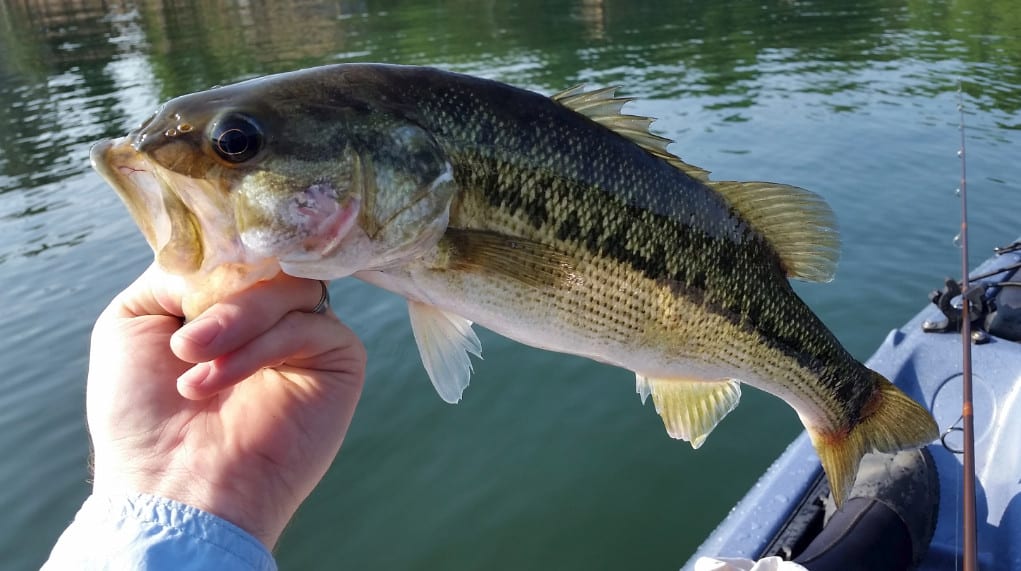
Spotted Bass (Micropterus Punctulatus) When hooked, the spotted bass will retreat to the bottom of the waterbed to hide, unlike the largemouth, which jumps up to free itself. They are equally feisty, though. Other differences will be the physical characteristics. The jaw on a spotted bass does not extend past the eye line. They have a dark-spotted lateral line and dark spots towards their bellies. Their habitat preferences are slightly different. They prefer areas with more current than largemouth bass but are too warm or muddled for smallmouth bass.

Smallmouth Bass: Anglers consider them excellent game fish because they are energetic and stubborn, which increases the thrill of catching them. They hardly submit once hooked and will often free themselves by jumping and twisting in the air. If caught deep, it will scramble for the closest cover, whether it is a weed or log, forcing the angler to work around it. Their tails are proportionately bigger than those of largemouths, so they have developed stronger swimming muscles and are also more streamlined. This combination makes them a formidable force. The males are smaller than the females with an adult weight of about 2lb, while the females average at 3 to 6 lbs. They grow to an average of 12 inches, with the largest recorded at 20 inches. They prefer clear, strong flowing streams, rivers, and lakes with gravel, boulders, or rock outcroppings. As much as they are also warm water species, they prefer cooler temperatures than the largemouths. Their larvae feed on zooplankton like water fleas before graduating to aquatic insect larvae and small fish, then crayfish and other fish like darters, minnows, yellow perch, and sunfish. In lake they tend to congregate – bring a fish finder. Largemouth Bass: This is the most prevalent game fish in the United States. It is so popular they even customize boat designs for efficient largemouth bass fishing. They have many professional associations and even more competitive tours for recreational bass fishing. Bass fishing is a multi-billion-dollar industry in the U.S., which has created employment for over 800,000 people. It is a member of the sunfish family, one of the black bass. Their average mature length is 15.7 inches, with the highest know being 38 inches. It has two subspecies: the Florida Bass and the Northern Largemouth Bass. The Florida Bass grows to a larger size than the Northern Largemouth. It prefers a quiet and clear environment and will be found in freshwater lakes, rivers, ponds, and swamps. Adults use submerged vegetation as cover while ambushing prey, while their young use weeds, logs, or stumps to avoid detection by predators. Their diet is insects, small fish, crayfish, frogs, and crustaceans. Illustrations by Thom Glace.
NOTE: White bass (Morone chrysops), striped bass (Morone saxatilis), and black sea bass (Centrophis stiata) are not closely related to the Micropterus genus, despite their common names. Instead, the Micropterus genus is part of the Centrarchid family, including sunfish and crappies. Surprisingly, largemouth bass can hybridize with some of their distant sunfish and crappie relatives. — University of Florida . . .
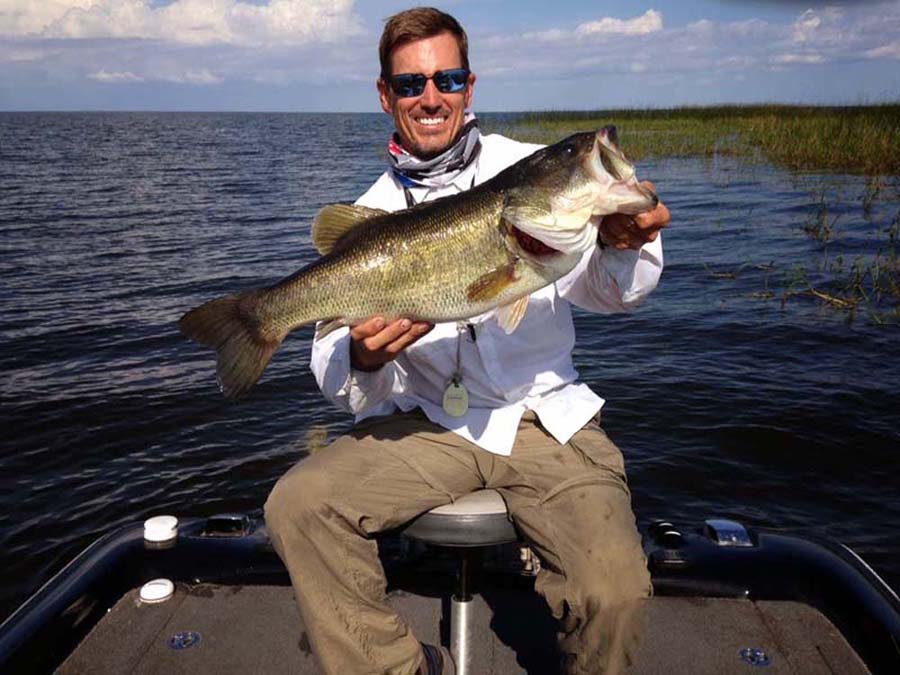
Thadeus Ragan, my forever guide when I lived in South Florida with a 10-pound Largemouth Bass from Lake Okeechobee. Ragan photo.
The most popular freshwater fish in the U. S., Largemouth Bass
By Skip Clement

where to find Black Bass Fish
Most of the largemouth bass’s sister species grow smaller and feed more on insects and small crayfish. Smallmouth and spotted bass feed on prey intermediate in size between that taken by the largemouth and its six sister species—the largemouth bass’s range overlaps with its sister species, occupying different ecological niches.
NOTE: Introducing intermediate feeders, like the smallmouth or spotted usually disrupts the ecosystems in rivers.
Largemouth bass is sometimes found in brackish waters located within salt marshes. Anglers catching them here still call them by their archaic common name of ‘green trout.’ Adult largemouth bass prey on smaller fish, frogs, crayfish, and occasionally birds and mice
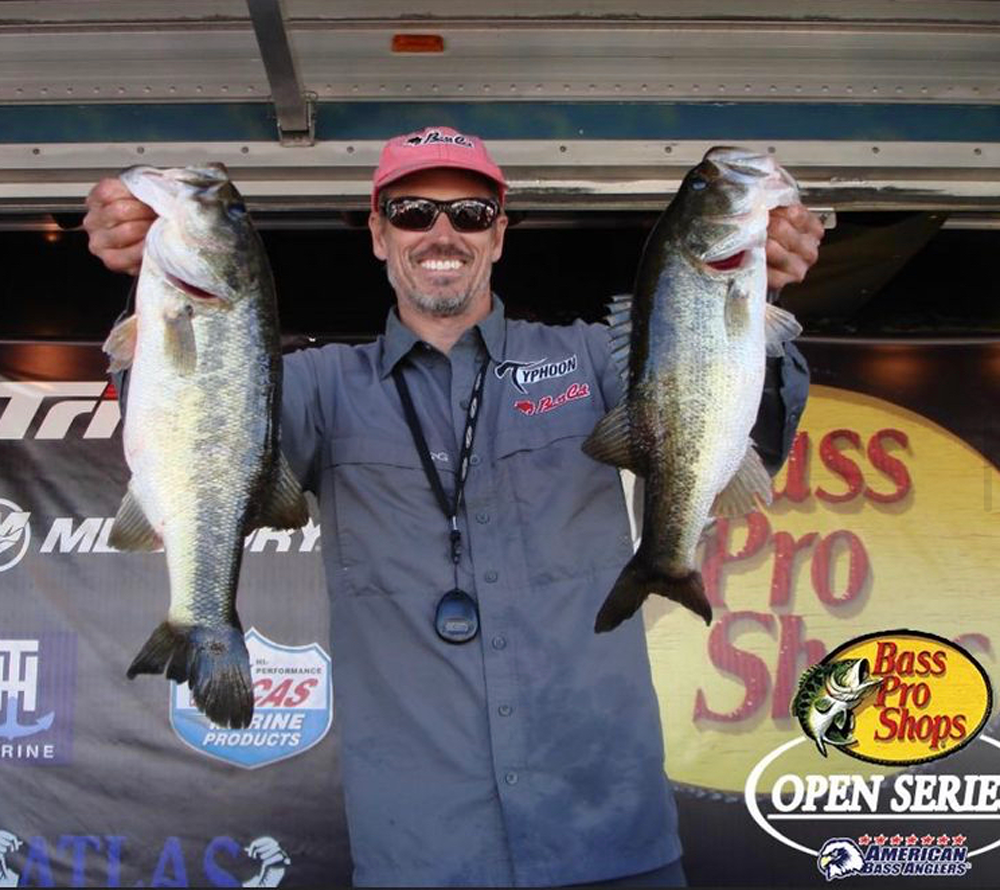
Thadeus Ragan is an old school ‘Tennessee Volunteer’ that headed south and landed in Miami. There he took up guiding and took it to a new level. Then entered the Bass Masters world and clawed his way upward and is now one of the big players in bass tournament circles. Thadeus guided me on many occasions, and rain or shine, he always found bass, even when others had motored away empty-handed. We fly-fished on all weather occasions and landed some 10s and many plus 5s. BTW: You can make it from the Atlantic side of South Florida to the West Coast of Florida if you are willing to portage a canoe or small outboard skiff and have no fear of snakes, gators, and panthers, and the most deadly of all, mosquitoes. You can reach Ragan here . . .
According to the US Fish and Wildlife Service’s National Survey of Fishing, Hunting and Wildlife Associated Recreation, largemouth bass are the number one sportfish in the USA, with almost a third of all freshwater fishing days accounting for them.
NOTE: Add in smallmouth, striped, white, sunshine and hybrids and the lure of the bass becomes clear.
That’s about 117 million days of targeting largemouth bass with an estimated 9.5 million fishermen casting a line foo them each year.
Expert analysts Southwick Associates actually put the largemouth bass as making up about 40% of all freshwater fishing in 2019.
And it believes the value of annual tackle purchases for largemouth bass totals a cool $2.97 billion (according to 2019 figures).
Not surprisingly, given the vast economic value of these species and fishing disciplines, bass fishing has seeped out around the world, with various species being stocked in other countries as an attractive – and lucrative – sport. — Southwick Associates, US Fish and Wildlife Service’s National Survey of Fishing, and Hunting and Wildlife Associated Recreation.

Largemouth Bass by Duane Raver.
The largemouth bass lives in all types of water: swamps, ponds, lakes, reservoirs, creeks, and large rivers
Largemouth bass can even be found in estuaries. During the winter, largemouth bass generally will move into deeper waters. In the spring, largemouth’s move into bays that have warmed up sooner than that of the main body of water. During the day, largemouth bass tend to cruise above aquatic plants at depths of three or four feet feet to about nine or ten feet or lie under lily pads or in the shade of overhanging trees, piers, or brush. In the evening hours at dusk and predawn largemouth bass tend to move into shallow water to feed. After night falls, they return to deeper water, where they rest on the bottom under logs or trees. In cold temperate climates, largemouth bass generally move into deeper waters during the winter months followed by movement to warmer, shallow waters in the springtime.
Conservation dedicated fly fishers are trending toward not disturbing spawning
There are discrepancies when it comes to temperatures in which largemouth bass will spawn. The variances are small, but a range less likely to be argued anywhere from 55- to 80-degrees – a 25-degree range. Some anglers with considerable experience have shared their thoughts and say temperature is overrated, but at either end, winter cold or August hot, it is paid attention to by any serious guides, and tournament anglers.
Some fly fishers are trending toward not disturbing spawning
A friend once said, after a remarkable day on Lake O [Lake Okeechobee], ‘I think these bass [largemouth] would hit a cadillac bumper if dragged off those lilly pads.’ For the greatest part, largemouth are more aggressive early in the am – like darkness to sunup, and at dusk to nightfall.
There are discrepancies when it comes to temperatures in which largemouth bass will spawn. The variances are small, but a range less likely to be argued anywhere from 55 to 80 degrees – a 25-degree range. Some anglers with considerable experience have shared their thoughts and say temperature is overrated, but at either end, winter cold or August hot, it is paid attention to by any serious guides, and tournament anglers.
Best temperatures for fishing for bass outside of spawning temperature is universally tied to feeding. Feeding rate is greatly influenced by temperature. Below about 50°F there is little, if any, natural feeding activity but beyond 50°F and near 68°F the feeding rate increases rapidly and remains high with temperature reaching around 81°, but above that, feeding tails off where adult bass in a [Florida study] remained quiet in shaded areas with their stomachs empty. This again verifies that predawn and post nightfall when water cools, create feeding windows.
Habitat
The largemouth bass lives in all types of water, including swamps, ponds, lakes, reservoirs, creeks and large rivers. The bass can even be found in estuaries. It prefers weedy oxbows and clears floodplain lakes. Since it is generally a warm water [81-86°F], fish, it is seldom found at depths of more than 18.8-feet. During the winter, largemouth bass generally will move into deeper waters. In the spring, largemouth’s migrate into bays that have warmed up sooner than that of the main body of water.
During the day, largemouth bass may cruise above aquatic plants at depths of 3.1-9.4-feet, or lie under lily pads or in the shade of overhanging trees, piers, or brush. In the evening hours, largemouth bass tend to move into shallow water to feed. After night falls, they return to deeper water, where they rest on the bottom under logs or trees. In cold temperate climates, largemouth bass generally move into deeper waters during the winter months followed by movement to warmer, shallow waters in the springtime.
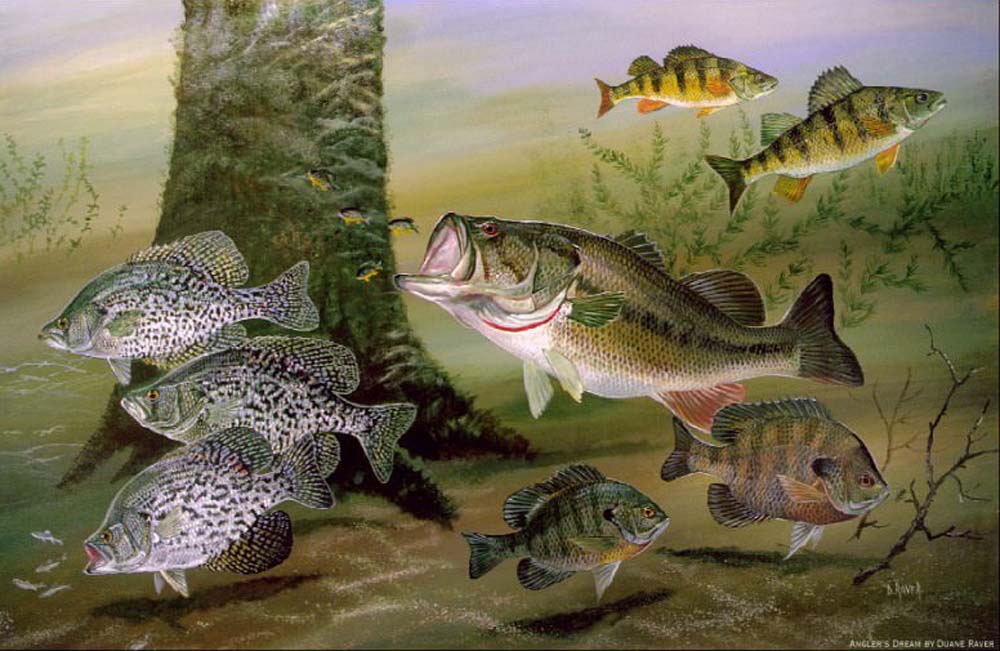
The gangs all here – Duane Raver
Tactics:
- Do whatever your guide tells you
- Seven and eight weight rods
- No need for long leaders
- Low light hours
- Do not lift the rod when feeling a bite
- Keep connected to the fly
- Keep rod tip right on top of the water
- Strip-strike or hard, low setting rod – like twisting your body
- Do not hurry popper retrieves, but do be inconsistent, erratic works fine
- Don’t be afraid to use sinking line
- Try big, bushy flies at night – 9-weight rod.
Some fly ideas:
- Whatever your guide selects from your offering or whatever they give you.
- Poppers – all sizes, all colors, all materials.
- Worms any and all.
- Frogs any color or size.


